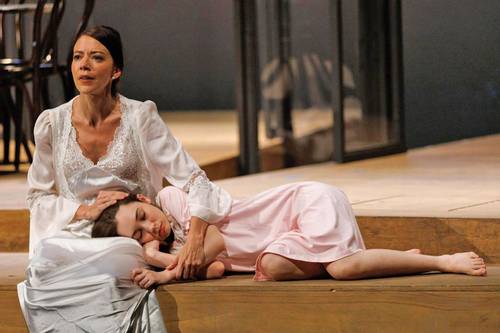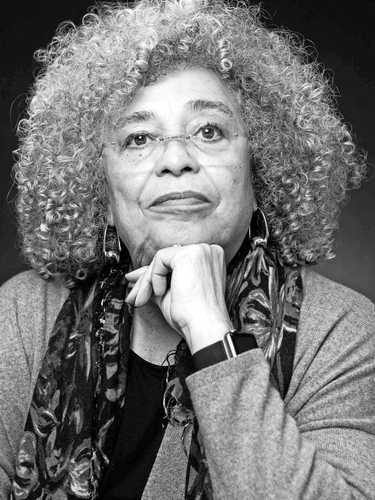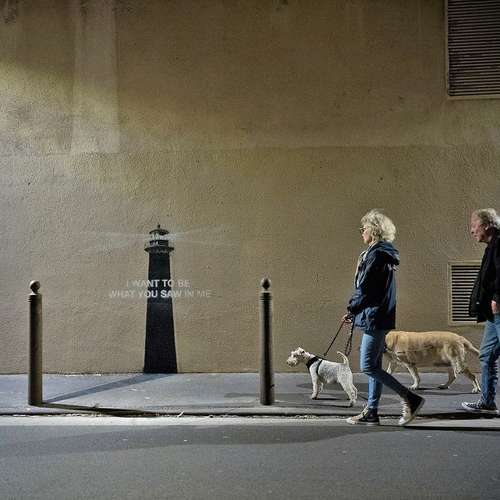Ravel's opera The Child and the Spells reveals the chiaroscuro of people

Ravel's opera The Child and the Spells reveals the chiaroscuro of people
The play premiered 100 years ago // An updated adaptation was staged last Sunday at the Chapultepec Scenic Garden // It will be presented at the Cenart
▲ A moment from the piece directed by Marcelo Lombardero. Photo courtesy of Inbal
Reyes Martínez Torrijos
La Jornada Newspaper, Tuesday, June 3, 2025, p. 4
The on-stage trial of a young boy's misdeeds, which brings together humanized objects and animals, becomes a discovery of the pain and goodness of beings in the short opera The Boy and the Sorcery, performed last Sunday at the Chapultepec Scenic Garden.
One hundred years after the premiere of this piece by composer Maurice Ravel and French writer Sidonie-Gabrielle Colette, an updated version was presented, incorporating new technologies commonly used by young people, but which still maintains the call to understand others.
The production, a collaboration between the Bellas Artes Opera Studio and the University of the Americas Puebla, featured baritone Marcelo Lombardero as artistic director and mezzo-soprano Cassandra Zoé Velasco, artistic coordinator of the National Institute of Fine Arts and Literature.
The adaptation of the piece, originally premiered at the Monte Carlo Opera in 1925, opens with a terraced space lined with giant computer keys, a gaming chair, and a large screen, where a very young subject is shown engrossed in a video game, surrounded by gray-clad figures; live piano chords can be heard in the background.
Tantrum with consequences
The scene is interrupted when he receives online messages from his mother, who asks him to do his homework and behave better. The response is the opposite: the boy flies into a rage and throws a destructive tantrum. " I don't want to do my homework
," he says, and lists the pranks he does want to do, like yelling at everyone, pulling the cat's tail... He assumes he's bad, free, and evil
.
The objects around him come to life. The armchair and chair he's leaning on throw him to the floor. They say: It's time to rid ourselves of that wicked child forever. No place for him to rest
. Immediately, a series of complaints follow: the clock reveals the damage it has received, the cup and teapot are in a fighting mood, in Chinese and German.
It's the turn of the enchanted princess, who is the protagonist of a text that fascinated him, who demands: You tore the book. What will happen to me? Will you regret not knowing the fate of your first love?
The protagonist begins to realize the danger he represents. The fire immediately rebukes him: Be careful. I warm the good. Be careful. I burn the bad
.
The worst is yet to come: the gathering of plants and animals, some of whom bleed sap, while others tell of how they were captured or lost partners, including trees, frogs, squirrels, cats, dragonflies, bats, and rabbits.
In the audience, a little girl interacts with what's happening. She repeats a few words. She marvels at the felines. Cat. Cat
, she points.
On stage, a crowd of animals surrounds the boy. In the background, an image of a nocturnal forest. The boy hears life's call to disrupt the natural order; its dominance and irresponsibility. Harassed, he complains about his abandonment. They've forgotten me. I'm alone. "Mom
," the boy exclaims as the furious crowd attacks him: "He must be punished. Let's unite
."
While they're attacking him, someone tells us that the protagonist healed a third person's leg, stopping the bleeding. This version dominates. They recognize that this act is good; the child is sensible
. The crowd applauds. "He's good and he's... so loving," they conclude. The audience immediately responds to the performance with a standing ovation.
At the end of the opera, Rodrigo Morales, one of the audience, told La Jornada that his daughter Constanza, who was present, is accustomed to the language of this artistic genre, having attended performances by the Ópera Portátil company and this second time this version of El niño y los sorcegios.
She said that her little girl, who is about four years old, finds it harder than other operas because this one is sung in French, but there are visual references that allow her to understand what she sees to a certain extent, and she has asked him questions about some things.
Morales emphasized that he finds it important to learn about opera, and that when there are works of this genre that are familiar to him, he takes advantage of them to share them with Constanza. However, he laments that sometimes the adult-centeredness
of a few attendees prevails, acting as if it were a solemn occasion and should exclude children.
The Boy and the Sorcery will be performed on June 28 and 29 at 12 and 2:30 p.m. at the Teatro de las Artes of the National Center for the Arts (Cenart), located at 79 Río Churubusco Avenue, Country Club neighborhood.
Admission costs 150 pesos.
Three stories about motherhood and mental health are staged at the Helénico Theater.

▲ Anatomy of a Suicide presents the stories of three generations of a family affected by the difficulties of relating to the world. Photo: Franyeli García / Ministry of Culture
Alondra Flores Soto
La Jornada Newspaper, Tuesday, June 3, 2025, p. 4
Are you happy?
is the question that haunts three women who simultaneously, each in their own time, bring to the stage a profound and haunting story about motherhood and mental health. The play "Anatomy of a Suicide" offers a unison triptych at the Teatro Helénico. Caro, Ana, and Ivonne represent different generations of the maternal line in a family affected by depression and difficulties relating to the world.
At one end of the stage, a window opens, revealing Caro, who is in the hospital after a suicide attempt in the late 1950s. The view then moves to the center, where Ana, who was in the 1980s, is also in the hospital for addiction problems. At the other end, Ivonne, a doctor in the present day, appears. Thus, three plays unfold, each depicting stories that at times intertwine with dialogue.
British author Alice Birch wrote the libretto, which, like a dramatic symphony, offers a poetic, intimate, and existential encounter with grief. Like a choral echo, at times it seems as if time merges, and the same concerns plague the protagonists. The play was recognized in 2018 with the Susan Smith Blackburn Prize for playwriting written by women in the English language.
On the occasion of the 2017 premiere at the Royal Court Theatre in London, Birch explained that when creating the play, she was thinking about what runs in families, particularly what it means to be a mother, the positive aspects and the difficulties it entails. She explained that she approached specialists who research suicide at Oxford University, and from there, she began to think about what it's like to live with someone whose mother took her own life.
The production, brought to Mexican theaters with translation by Paula Zelaya, is directed by Cristian Magaloni. Fernanda Castillo, Paula Watson, and Diana Sedano lead a stage production that confronts the audience with two hours of complexity and honesty about depression, loneliness, and inherited scars. Flashes of humor shine through at times.
Underneath, preconceived ideas about women and motherhood prevail. This includes meeting those closest to them and the difficulty of understanding the emotions of those who no longer wish to be in the world. Symbolically, the family home represents the emotional burden passed down from mother to daughter, the chaos and difficulties in developing as individuals.
The rest of the cast includes Amanda Farah, Montserrat Ángeles Peralta, Antón Araiza, Hamlet Ramírez, Santiago Zenteno, and Lucía Ribeiro.
Julieta Egurrola and Ana Serradilla were the godmothers at the season premiere on May 24. While the seasoned actress praised the interesting and complex work
, her younger colleague considered the theatrical production to be an art form with a much-needed message honoring mothers and grandmothers, as well as understanding that time is only one. And more powerfully, it addresses in a very poetic way mental health, intergenerational issues, and the fact that love is the most important thing.
Anatomy of a Suicide concludes its season on June 22nd at the Helénico Theater, located at 1500 Avenida Revolución, Guadalupe Inn. Performances are Fridays and Saturdays at 7:00 p.m., and Sundays at 6:00 p.m.
Angela Davis's anti-racist ideology serves women in Latin America, says researcher
Criminologist Lucía Núñez coordinates a seminar dedicated to the American activist.

▲ American academic and activist Angela Davis, born in Alabama in 1944. Photo taken from Wikimedia Commons
Alondra Flores Soto
La Jornada Newspaper, Tuesday, June 3, 2025, p. 5
Reading Angela Davis (Alabama, 1944), an African-American academic and activist, is important because much of her thinking and actions serve to reflect on Latin American countries from an anti-racist, critical perspective and not only in terms of a feminism removed from other series of oppressions, such as class, race and sexuality, says researcher and criminologist Lucía Núñez.
The Center for Gender Research and Studies (CIEG) convened the Angela Davis Seminar for its fifth year. The purpose of this seminar is to discuss paths of thought based on three axes of analysis: anti-prison feminism; gender and sexuality; and race, class, and pigmentocracy.
She always gives us clues and insights so we can avoid sectarianism as feminists, but rather think that there are several fronts to open up the political subject. Feminism is not only a woman's idea, but also a struggle that must be broad, anti-sexist, anti-racist, and anti-capitalist.
An experience of struggle
Lucía Núñez, coordinator of the seminar along with Chloé Constant, points out: we return to the thinking of Angela Davis, even though she is an American of African descent, because she has had experience in the theoretical struggle as an academic and as a practical activist
.
So, she mentions, being a Black feminist also allows us to take critical stances against repressive apparatuses
. In contexts of gender-based violence, it has been very important to consider and question the methods of social control offered by the State, to understand whether prison and militarization are double-edged swords in Latin American countries.
Davis was active in the Communist Party and remained very close to the Black Panthers, although she didn't belong to the group, and she learned a lot. All of this, along with her theoretical experiences and the repression she endured for being a Black woman of the left, shows that in difficult times she forged strong alliances among disadvantaged sectors
.
Forty years after the book Women, Race, and Class (1981), she continues to leave us with much to think about; furthermore, she presents her positions not from the perspective of identity politics, which we might say is that women are a single, homogeneous group. Depending on the political, cultural, and economic situation, our needs and experiences are different. We sorely miss that in Latin America and in feminism.
The seminar Readings on the Thought of Angela Davis launched its fifth call for applications (which closed on May 23). This year, more than 300 applications were received for this free initiative, which has a capacity for 30 people.
It's been
very difficult; however, it's not an elitist issue. We'd like to open a seminar for everyone, but it's not possible to discuss it in large groups
. The participants read the text and began discussing with thought-provoking questions about what's happening to us in Mexico, in Latin America, and about what Angela was experiencing, the challenges and challenges she faced in her struggle
.
The seminar has a hybrid format due to participation from countries such as Colombia, Ecuador, Peru, and Bolivia. Those in Mexico City will travel to the Humanities Tower II at Ciudad Universitaria, where the sessions are held, while the rest will connect remotely. The activities will begin on August 26 and conclude on October 21.
During those days, as has been the case for five years, we discuss the issues that unite us, that make us similar and different. But there is one issue that, as Latin Americans and as colonized countries, we do find and see common ground in several of our problems, our problems as women, but also those of people of sexual diversity
.
In Marseille, Internet users reveal Banksy's new stencil

▲ Image of the graffiti artist's most recent painting. Photo Ap
The Independent
La Jornada Newspaper, Tuesday, June 3, 2025, p. 5
Banksy's latest work has been revealed, and internet researchers were quick to pinpoint its location. The black and white graffiti depicts a lighthouse with light radiating from its tower, with the caption: I want to be what you saw in me
.
Banksy posted the work on his Instagram last Thursday with two photos: one showing only the painting and another showing two people walking their dogs. Many internet users quickly identified the work in Marseille, southern France.
The mural is located on Rue Félix Freiger, a street close to the waterfront and the city center. The quote on the wall could be inspired by a song by the Tennessee country band Lonestar, called Softly, whose lyrics say: "I wanna be what you see in me. I wanna love you like you love me
."
London-based art dealer MyArtBroker wrote on its website: “The mural’s location is unlikely to be coincidental. Marseille, France’s oldest port and one of its most multicultural cities, has long been a point of arrival and transition.
Its neighborhoods, from Le Panier to Belle de Mai, are marked by layers of street art and stories shaped by the resilience of working-class and immigrant communities. The city's social fabric resonates with Banksy's abiding interest in marginalized voices and ignored narratives.
Rulfo in his own voice, tomorrow at the Sound Library
From the Editorial Staff
La Jornada Newspaper, Tuesday, June 3, 2025, p. 5
The National Sound Library will host the second session of the Ateneo de la Escucha (Listening Athenaeum), dedicated to the voice of Juan Rulfo, author of the novel Pedro Páramo and the short story collection El llano en llamas ( The Burning Plain).
Tomorrow, during the event, these historical archives will be heard and discussed, with the author reading excerpts from his work. The recordings, made for the Voz Viva collection, are part of a sound collection celebrating 65 years of existence.
This material is recognized as cultural heritage by the National Autonomous University of Mexico, as well as by the United Nations Educational, Scientific and Cultural Organization, as part of the Memory of the World program.
The writer Felipe Garrido, who will also participate in the listening session, believes that Juan Rulfo's voice reflects all the traits of his style: the lack of fuss, the sarcasm, and the ability to contain intense emotions with moving simplicity
.
The listening session will feature filmmaker and son of the author, Juan Carlos Rulfo; Julio Estrada, musicologist and researcher; and Felipe Garrido, writer and academic. Perla Olivia Rodríguez, researcher and director of the Institute for Library and Information Research, will host the session.
Juan Rulfo's narrative can be heard tomorrow at 7 p.m. in the Murray Schafer auditorium of the National Sound Library (Francisco Sosa 383, Santa Catarina neighborhood, Coyoacán, with free admission and limited capacity for 80 people.
jornada





